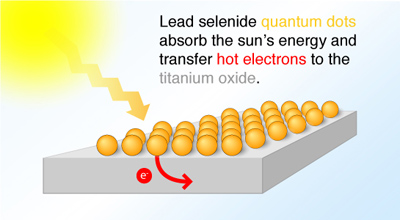Solar Cell Efficiency Heats Up At UT

UT scientists think they know a way to make solar cells dramatically more efficient. The secret: a nifty-sounding bit of technology called quantum dots.
Quantum dots (or more formally, semiconductor nanocrystals) could capture more solar energy, the team says. The efficiency rate of the conventional silicon solar cells most commonly used today is around 30 percent; the rate for cells using quantum dots could be up to 66 percent, they say.
The findings of chemist Xiaoyang Zhu and his fellow researchers are reported in this week's Science.
Zhu predicts great possibilities and gains for solar energy. "There is no reason we cannot be using solar energy 100 percent within 50 years," he says.
If you like the sound of that, check out the July|August Alcalde, which will include an update story on the ways UT is going green. One attention-getting possibility: converting the Godzillatron in DKR-Texas Memorial Stadium to solar power. A group of professors and students has been researching the idea. Their next step is finding funding for a feasibility study.
And who knows? Maybe it could someday employ quantum dot technology.





